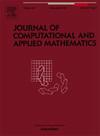基于无限近端Peaceman-Rachford分裂方法的图像恢复中可分离凸规划问题的综合加速算法
IF 2.1
2区 数学
Q1 MATHEMATICS, APPLIED
Journal of Computational and Applied Mathematics
Pub Date : 2025-04-21
DOI:10.1016/j.cam.2025.116693
引用次数: 0
摘要
考虑线性约束的可分离凸优化问题,目标函数是两个独立的扩展实值函数的和。在常用的凸组合技术的基础上,利用不确定近端正则化技术,提出了一种新的Peaceman-Rachford分割方法。将泛化加速技术集成到第一个子问题的近端项中,其中近端矩阵可以是正半定的,以保证上述子问题解的存在性。此外,我们允许第二子问题的近端矩阵是不定的,但理论上仍然保证了所提方法的收敛性。值得一提的是,泛化加速步长的系数范围可以从[0.618,1]扩展到(- 1,1)。在一些温和的条件下,我们建立了全局收敛性和遍历O(1N)次线性收敛率,由函数值残差和约束违反度量,其中N为迭代次数。据我们所知,这是第一次使用泛化加速技术来加速基于prsm的方法的收敛。最后,通过数值实验验证了该算法在LASSO和全变分图像恢复问题中的有效性。本文章由计算机程序翻译,如有差异,请以英文原文为准。
An indefinite proximal Peaceman–Rachford splitting method-based algorithm integrating the generalization acceleration technique for separable convex programming problems in image restoration
In this paper, we consider the linearly constrained separable convex optimization problem, where the objective function is the sum of two individual extended real-valued functions without coupled variables. Based on the common convex combination technique and with the help of the indefinite proximal regularization technique, we propose a novel Peaceman–Rachford splitting method (PRSM). The generalization acceleration technique is integrated into the proximal term of the first subproblem, where the proximal matrix could be positive semidefinite so as to ensure the solution existence of the just-mentioned subproblem. Moreover, we allow the proximal matrix in the second subproblem to be indefinite but still guaranteeing the convergence of the proposed method theoretically. It is worth to mention that the range of the coefficient for the generalization acceleration step can be extended from to . Under some mild conditions, we establish the global convergence and ergodic sublinear convergence rate measured by the function value residual and constraint violation, where denotes the number of iterations. To our knowledge, this is the first time that the generalization acceleration technique has been used to accelerate the convergence of PRSM-based methods. Finally, numerical experiments allow to verify the effectiveness of the proposed algorithm in solving LASSO and total variation image restoration problems.
求助全文
通过发布文献求助,成功后即可免费获取论文全文。
去求助
来源期刊
CiteScore
5.40
自引率
4.20%
发文量
437
审稿时长
3.0 months
期刊介绍:
The Journal of Computational and Applied Mathematics publishes original papers of high scientific value in all areas of computational and applied mathematics. The main interest of the Journal is in papers that describe and analyze new computational techniques for solving scientific or engineering problems. Also the improved analysis, including the effectiveness and applicability, of existing methods and algorithms is of importance. The computational efficiency (e.g. the convergence, stability, accuracy, ...) should be proved and illustrated by nontrivial numerical examples. Papers describing only variants of existing methods, without adding significant new computational properties are not of interest.
The audience consists of: applied mathematicians, numerical analysts, computational scientists and engineers.

 求助内容:
求助内容: 应助结果提醒方式:
应助结果提醒方式:


